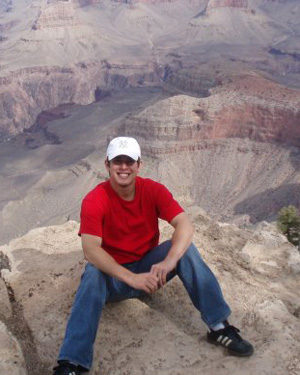
VetsFirst NSO Stephen Fricano taking in the sights
at the Grand Canyon.
When I first enrolled in the VA healthcare system, it was the fall of 2009, and I was fresh out of the U.S. Air Force. With the assistance of the excellent people of my local VA Medical Center––as well as that of United Spinal Association, the company for which I now have the pleasure of working for––my claims for service-connected disability were investigated, evaluated and in due time, approved.
After this came my move to Buffalo, and my enrollment in the Buffalo VA Medical Center. It was there at the Buffalo VAMC that a doctor would find something that would truly change the way I see, literally!
“Mr. Fricano, I’m going to need another look at that eye,” the doctor said.
The simplicity of the statement threw me off balance, given what has transpired since it was uttered. It was only six short months ago, but what my VA optometrist saw through her technical equipment that day will have a lasting effect on the rest of my life.
As it turns out, I had two very small tears in the retina of my left eye, and she was the first person to observe this and bring it to my attention. I was informed that she would start making all the necessary calls and hopefully get me in to Ophthalmology as soon as possible.
I sat in the eye doctor’s chair, waiting to hear when my next appointment would be, and what this means for my sight, when I was informed that the ophthalmologist would actually be ready to see me within the hour. Soon, I was in another chair, in another office, talking to another doctor. As we started to talk specifics, the doctor told me that, while the two tears in my retina were relatively minor, they were closer enough together that, with time, they could become one larger tear. This posed a serious threat to become retinal detachment. We discussed the options in my case: wait and see, or corrective surgery. After doing a bit of research on my own, at home, I opted for the retinal surgery.
It was a fine, brisk morning in western NY, when I found myself back in the same office at the Buffalo VAMC. Per the doctor’s orders, I had worn my glasses, and kept taking them off to polish at the lenses nervously. The doctor brought in two medical students who were enrolled at the local SUNY Buffalo state university; they were there as part of a partnership between the Buffalo VAMC and the college, to observe and study in their chosen field.
After the preliminary tests and confirmation of the diagnosis by all parties, I was instructed to head to the operating room. As our small group passed into the designated room, I immediately spotted the equipment that would correct my problem. It was an optical laser interface machine, designed, through the use of special lenses and controls, to let a technician or doctor aim and use a powerful green laser to literally scar the eye around the tears. This would prevent the tears from ever becoming larger.
As I was coached on what I’d be experiencing, I had my eyes prepped for surgery, the doctor joked with me to keep the tension down. The experience of actually getting the surgery is a bit of a blur, with instructions to keep looking straight, praise that I was doing great, and continual statements that we were almost done. If I had to compare it to something else, I’d say it was a lot like watching an extremely bright laser show with your eyes closed. I’d get glimpses of the green laser out of my peripheral vision, but since the doctor had a steady hand, and apparently I kept my eyes relatively straight and motionless, the surgery went off without a hitch.
Many people speak of light-affected migraines; my main symptom of the healing process from the surgery was something similar. After a few days, though, the majority of the pain and discomfort had passed. In a few weeks, I was back in the Buffalo VAMC for my follow-up. The doctor informed me that the small ring of burns created by the laser to contain the tears had been very successful. Barring the creation of new tears, which are normally created by minor blunt trauma (hitting your head on something, or a hard football tackle), my prognosis was that I may have some minor disturbances in my peripheral vision, but that I was now at an extremely low risk for retinal detachment.
Because of the dedication and attention to detail by the staff of the Buffalo VAMC, I was diagnosed and treated before my condition could have been a real problem. Due to their expertise and caring, as well as the support of my coworkers, my vision forecast for the future is, in a word: clear.
So if I had any word of advice for my fellow vets, it’d be this; if you have any medical issues, be it vision related or something completely different –– it may be covered by VA. Should you have any questions, please let us know. We’re always here to help you sort it out!
Stephen Fricano
National Service Officer
